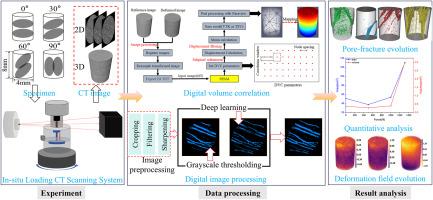Influence of bedding orientation on shale damage evolution: A combined in-situ micro-CT and digital volume correlation investigation
IF 7
引用次数: 0
Abstract
The bedding structure of shale significantly influences its mechanical anisotropy. However, the meso-scale anisotropic control mechanism of bedding on shale damage evolution remains insufficiently understood. This study employs in-situ uniaxial compression CT scanning experiments, combined with grayscale thresholding and deep learning-based image segmentation, to achieve high-precision 3D reconstructions of shale pore-fracture networks. Additionally, by integrating Digital Volume Correlation (DVC) with image analysis, a cross-scale quantitative characterization and synergistic evaluation are conducted, bridging the evolution of microstructural damage with macroscopic full-field deformation in bedded shale. The results reveal that: (1) The dominant geometric factors influencing the complexity of the shale pore-fracture network during loading vary with bedding orientation: number and spatial distribution dominate for 0° shale, volume and area for 30°/60° shale, and coupled geometric parameters for 90° shale. (2) Displacement and strain fields exhibit distinct characteristics related to the bedding angle: 0° shale shows quasi-uniform deformation dominated by axial compaction; 30° and 60° shales form significant strain concentration bands along bedding planes due to shear slip effects; 90° shale is driven by radial tension, leading to tensile strain localization parallel to the bedding direction. (3) The strain accommodation mechanism in shale transitions with the bedding angle: it shifts from being dominated by matrix compaction and diffuse micro-damage at low angles to being primarily controlled by fracture propagation along bedding planes at high angles. In high-angle bedded shale, pre-existing pores and fractures tend to preferentially act as nucleation sites for damage initiation and strain localization.

层理取向对页岩损伤演化的影响:原位微ct与数字体积相关研究
页岩的层理结构对其力学各向异性有显著影响。然而,层理对页岩损伤演化的细观各向异性控制机制尚不清楚。本研究采用原位单轴压缩CT扫描实验,结合灰度阈值分割和基于深度学习的图像分割,实现页岩孔隙-裂缝网络的高精度三维重建。此外,通过数字体积相关(Digital Volume Correlation, DVC)与图像分析相结合,进行了跨尺度定量表征和协同评价,架起了层状页岩微观结构损伤演化与宏观全场变形的桥梁。结果表明:(1)影响加载过程中页岩孔隙-裂缝网络复杂性的主要几何因素随层理方向的不同而不同:0°页岩以数量和空间分布为主,30°/60°页岩以体积和面积为主,90°页岩以耦合几何参数为主。(2)位移场和应变场随层理角度变化特征明显:0°页岩表现为轴向压实主导的准均匀变形;30°和60°页岩受剪切滑移影响沿顺层面形成显著的应变集中带;90°页岩受径向张力驱动,拉伸应变局部化方向与顺层方向平行。(3)页岩应变调节机制随层理角度发生转变,由低角度下以基质压实和弥漫性微损伤为主转变为高角度下以裂缝沿层理面扩展为主。在高角度层状页岩中,原有孔隙和裂缝往往优先作为损伤起核和应变局部化的成核场所。
本文章由计算机程序翻译,如有差异,请以英文原文为准。
求助全文
约1分钟内获得全文
求助全文

 求助内容:
求助内容: 应助结果提醒方式:
应助结果提醒方式:


